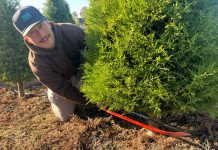Should you be stopped for a traffic violation by Hollister
Police officer Tony Lamonica, it would be wise not to try to joke
your way out of a citation with lines such as these.
Should you be stopped for a traffic violation by Hollister Police officer Tony Lamonica, it would be wise not to try to joke your way out of a citation with lines such as these:
The Hollister Police Department is going to the dogs.
It’s a dog’s life in the HPD.
Does your partner want a bone?
Lamonica might appreciate such humor. His partner, on the other hand, might take it personally.
Officer Quinn, currently the sole member of the HPD’s K-9 corps, is a Belgian Malinois, a breed of the herding group of dogs. Not quite 4 years old, Quinn’s advantages in police work are many. His senses of smell and hearing are many times greater than his two-legged counterparts’. His four legs move him much faster – not to mention more quietly – and once his jaws lock onto a suspect, they’re not likely to release until Lamonica gives the command.
Even then, a suspect wouldn’t know what’s going on. For safety reasons, commands are given in German or Czech, depending on which language a K-9 officer and his handler have been trained in. Even the most unusual of English code words could trigger an unwanted attack.
But, Lamonica explained to the seventh class of the Hollister Citizens Police Academy Wednesday night, attacks by K-9 officers – at least, those of Quinn’s breed – aren’t as vicious as they might look.
“It’s all a game for these dogs,” Lamonica said. “They’re not out to hurt anybody.”
That’s one of the advantages of employing Belgian Malinois over the more traditional German shepherd in police work. The shepherd is a more aggressive breed, and, as Lamonica explained, “We want an even-tempered dog.”
Until called upon to show his stuff, Quinn lay quietly at the front of the HPD conference room, occasionally perking his ears at a sudden sound. Class members petted him and – because Lamonica was there – he responded with affection.
According to the American Kennel Club, Belgian Malinois are “confident, exhibiting neither shyness nor aggressiveness in new situations… He is naturally protective of his owner’s person and property without being overly aggressive.”
Last year, two Hollister Police K-9 officers – including Mello, who’s no longer with the department – were involved in 58 arrests, 67 patrol deployments and 109 drug searches.
Only three times was a suspect bitten, all three by Mello. One of the three suspects, Lamonica said, made the mistake of putting his hand inside the police car in which Mello was riding.
One other point made by the AKC is a key in police work: “The Belgian Malinois possesses a strong desire to work and is quick and responsive to commands from his owner.”
That was evident when Lamonica and Quinn, with help from HPD officer Kelly Burbank, put on a demonstration for the class. Burbank, truly a brave man, donned a protective suit as thick as two or three quilts to play the bad guy and walked away from the two officers.
On Lamonica’s command in German, Quinn rocketed after Burbank, leaping to get his heavily padded arm in an unrelenting grip. On a second run, Quinn jumped and hit Burbank squarely in the butt, knocking him to the ground with a pratfall worthy of the Keystone Kops.
“When a bad guy runs, dogs pick up on the scent of fear,” Lamonica said. “Their nose is 10 times as powerful as a human’s.”
But apprehension by a K-9 can take on a passive role as well. In “bark and hold,” a suspect’s attention is on the dog, not the two-legged officer. A K-9 can also circle his partner and a suspect during a confrontation, diverting the suspect’s attention. And, since many people have a basic fear of dogs – or at least of being bitten – their mere presence can be intimidating.
“A lot of times, you go to fights,” Lamonica said. “As soon as the dog gets there, everybody scatters. It’s a big deterrent.”
Dogs’ acute sense of smell also gives police a huge advantage in drug searches. The Los Angeles Police Department proved the value of drug-sniffing dogs in the 1960s by training them to find marijuana wrapped in several layers of aluminum foil and plastic, placed in a box inside another box and hidden behind more boxes. One LAPD K-9 was so adept at sniffing out drugs that the drug-running underworld paid him the ultimate compliment – they put a price on his head.
Training of K-9 officers is intense, and not just for the dog. K-9s go through 1,000 hours of training before certification and once on the force, both the dog and his partner train three to four hours per week on commands and tactics.
The relationship doesn’t end when the blue uniform comes off, either. To enhance the bond between K-9 and partner, the dogs live with the officer and his family.
“Oh, he’s my best friend,” Lamonica said in response to a question. “I trust him more than any other officer in this department. When you have your best friend riding with you all the time, it feels great.”
Two wheels, 24 speeds… and stealth
Police have ridden motorcycles almost as long as Harley-Davidson has been rolling the machines off its Milwaukee assembly line, and the image of motorcycle cops hiding behind bushes and billboards to catch speeders is so legendary that it’s been portrayed in dozens of cartoons.
But there’s another two-wheeled vehicle that’s become popular in law enforcement. Some 2,000 police agencies nationwide now use bicycle patrols.
It’s the kind of job that was made for HPD officer Dan Devane. A former Hayward Police officer, Devane’s dream assignment was bicycle patrol at California State University, Hayward – on a campus with a 400-foot difference between its highest and lowest points.
When Capt. Richard Vasquez engineered the HPD’s bicycle patrol a little over a year ago, Devane embraced it.
“My eyes lit up,” he said. “I ride at night, I ride in the rain. If they wanted me to, I’d ride 40 hours a week, 365 days a year.”
Devane is so married to his mount – a 24-speed bike made by Smith & Wesson – that he rode it into the conference room Wednesday night, first dousing the room lights to show off the bike’s flashing red and white strobes.
“That was fun,” he said after dismounting. “That’s one of the good things about bike patrol. It’s a serious tool but you can have fun with it.”
You don’t have to get tired riding it, either. The $1,900 bicycle sports a two-speed electric motor made by Zero Air Pollution that will propel it at speeds up to 18 mph. Devane said the motor and some pedal power will get him to the top of Park Hill so fast that it surprises officers who made the trip in patrol cars. On level ground, it can be even better.
“I’ve gone from San Benito and Fourth to Nash and Line and beaten three patrol cars,” Devane said.
The bike is equipped with a siren capable of 115 decibels (as loud as a patrol car siren) and a saddlebag for such accouterments as handcuffs, a citation pad, binoculars and a first aid mask – and two bungee cords to strap confiscated skateboards to the frame.
“Those guys (skateboarders) hate me,” Devane said, with pride. “They’re out there riding – no helmet, no nothin’ – and all of a sudden, I ride up. They actually post lookouts when they know I’m working.”
That’s the bike’s biggest advantage: stealth. A few months ago, Devane was the first officer to arrive at a gang fight near Cerra Vista School.
“They didn’t even see me coming,” he said. “I I.D.’ed every one of ’em.”
But Devane has nothing against skateboarders or kids. The father of a 13-year-old boy, he simply hates to see skaters without protective gear, and if the threat of a citation will get them to put on a helmet and pads, so be it.
Devane himself is a riding advertisement for bicycle safety, wearing so much gear that he resembles the Pillsbury Doughboy, trading the chef’s hat for a helmet and adding goggles and gloves. His pants and jacket are reflective and waterproof and his outfit is layered for adjustment to changes in the weather. He even has special riding socks embroidered with “Got Donuts?”
Obviously a man who enjoys his job, Devane also takes it seriously. He has the tactics of apprehending suspects with the bike down to a science.
With HPD officer Parveen Lal in the role of the suspect, Devane displayed for the class such moves as the “step through and stop” and the “power slide,” as well as how the bike can be used as a wall between him and a suspect, or between a suspect and escape, and even as a weapon.
In the “power slide,” Devane sped silently past Lal, throwing the bike into a skid directly in Lal’s path. Then, with Lal feigning aggression, Devane lifted the rear wheel and swung it at Lal almost as quickly as he could throw a right cross.
The bicycle has another advantage over patrol cars: it can get into places a car can’t. While that aids in pursuits, it also means Devane can make himself quite visible if he wants to – and sometimes he does.
“It serves a dual purpose – enforcement and public relations,” he said.
“It gets me out into the community, which is what I love. I love being outdoors. You sit in a car and it’s not the same. (On the bike) you get more personal contact.”
But that can also make him vulnerable while riding in downtown traffic.
“People cut me off and I hit them with the light and siren,” he said. “I say, ‘Didn’t you see me?’ They say, ‘Yeah, but I didn’t realize you were a cop.’ Sometimes my attitude comes out because it’s like, ‘You’re not even concerned. You almost hit me and you’ve got 3,000 pounds of car and I’ve got a bike.'”
Devane often makes house calls at businesses and says the idea of the bike patrol seems to be a hit with Hollister merchants.
“It allows us to diversify,” Capt. Bob Brooks said. “To meet needs we haven’t been able to meet before.”
And as far as Devane’s concerned, there’s one more advantage.
“One of the benefits I’ve found with the bike patrol is it keeps older officers like me – I’ve got 17 years’ experience – it keeps us motivated.”









